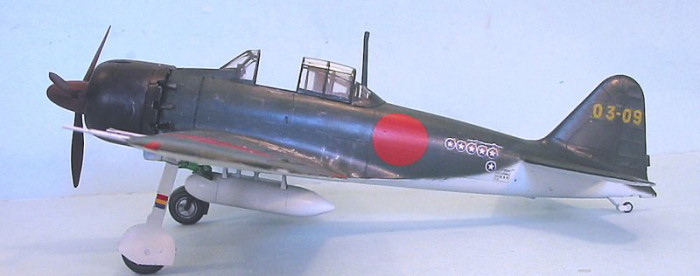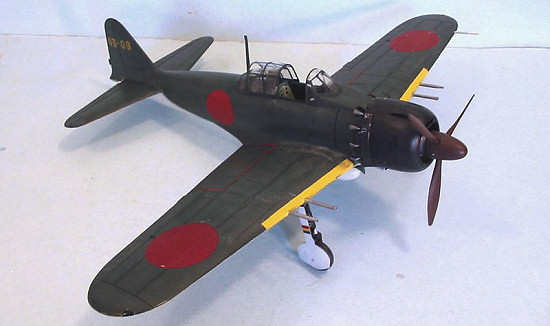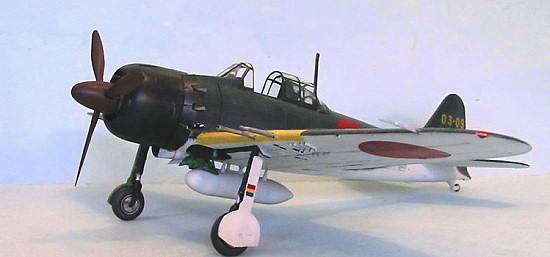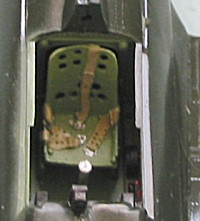
Hasegawa 1/32 A6M5c Zero
| KIT #: | ? |
| PRICE: | $ Currently OOP (May 2006) |
| DECALS: | See review |
| REVIEWER: | Tom Cleaver |
| NOTES: | UMI Resins corrected cowling used |

| HISTORY |
By late 1942, it was obvious to any knowledgeable observer that the Mitsubishi Zero-Sen was being rapidly outclassed by the latest Allied fighters being introduced in the Pacific, such as the P-38 Lightning, which made its combat debut with one squadron in New Guinea in December 1942. The next year would confirm this to any but the diehards, as first the Vought F4U Corsair and then the Grumman F6F Hellcat began to scythe down the Imperial Navy's premiere fighter.
Mitsubishi proposed that the Zero be re-engined to provide more power, so that
the addition of heavier armament, armor and self-sealing fuel tanks would not
degrade performance. The Imperial Navy refused, and required that the Zero
continue in production with the Sakae 21 engine. The result was the  A6M5
series, which would be produced at both Mitsubishi and Nakajima in greater
numbers than all other Zero models combined. This featured wings shortened like
the A6M3 Model 32, but with rounded wingtips and a strengthened wing that
allowed higher diving speeds, coupled with a complete redesign of the engine
cowling and installation of single thrust-type exhausts, while the main armament
was changed to the belt-fed Type 99-2 Model 4 20mm cannon.
A6M5
series, which would be produced at both Mitsubishi and Nakajima in greater
numbers than all other Zero models combined. This featured wings shortened like
the A6M3 Model 32, but with rounded wingtips and a strengthened wing that
allowed higher diving speeds, coupled with a complete redesign of the engine
cowling and installation of single thrust-type exhausts, while the main armament
was changed to the belt-fed Type 99-2 Model 4 20mm cannon.
The resulting Model 52a was still considered inadequate, and the Model A6M5b Otsu appeared in early 1944. The 7.7mm cowling guns were changed, with the port weapon replaced by a 13mm machine gun, and 470 of these were constructed by Hei
Mitsubishi. This was still not enough; the Model 52c, the Hei, appeared shortly after, with armament further increased by a single 13mm machinegun in each wing alongside the 20mm weapon. While it had been planned to power this significantly-heavier Zero with a version of the Sakae that had water-methanol injection, this engine was not available in time to be installed in production Model 52c aircraft. The result was that with the Sakae 21 and the additional weight of armor plate, self-sealing fuel tanks and more armament, the A6M5c was significantly heavier, with no increase in power. As a result, performance - which at a maximum speed of 358 m.p.h. for the lightweight Model 52a was still below Western standards - was significantly degraded to 352 m.p.h.. Only 93 Model Hei Zeros - all built by Mitsubishi - would be produced before it was terminated in favor of the A6M5a in the summer of 1944.
Warrant Officer Takeo Tanimizu entered flight training in 1941 and graduated as fighter pilot in March, 1942. He was fortunate to be among the last Japanese fighter pilots to receive the benefit of prewar-quality training. He was assigned to the carrier Shokaku in 1943 and finally entered combat at Rabaul on November 2, 1943, when the Shokaku air group was transferred from Truk to that Rabaul to increase the air defenses in the face of increased Allied attacks.
 By
the time the bulk of the surviving Japanese air units were evacuated from Rabaul
in February 1944, Tanimizu was a leading ace. In March, he became an
instruction with the Tainan Air Group in Japan. That summer he was transferred
to Formosa; on the night of August 31, 1944, he engaged 11 B-24s attacking
Kaohsiung (then called Takao). He shot down one B-24 which exploded, and
damaged another so badly that it later crashed in the mountains of
southwestern China. The remains of this airplane were not discovered until
October 1996.
By
the time the bulk of the surviving Japanese air units were evacuated from Rabaul
in February 1944, Tanimizu was a leading ace. In March, he became an
instruction with the Tainan Air Group in Japan. That summer he was transferred
to Formosa; on the night of August 31, 1944, he engaged 11 B-24s attacking
Kaohsiung (then called Takao). He shot down one B-24 which exploded, and
damaged another so badly that it later crashed in the mountains of
southwestern China. The remains of this airplane were not discovered until
October 1996.
After recovering from wounds received when he was shot down over Amoy on November 3, 1944, Tanimizu was assigned to the 203rd Naval Air Group in Japan, where he chose to fly the A6M5c because of its heavier armament. Flying his Model 52c, he shot down two Corsairs of VFB-83 on March 10, 1945. On June 10, he engaged in a fight with P-47Ns over Kyushu, in which he was badly shot up after damaging two of the enemy, and had to make a forced landing. During this period of service with the 203rd NAG, he began formally marking his Zero with victory symbols, to build up morale among the younger, poorly-trained pilots for whom he was responsible.
When the surrender was announced, Tanimizu was among those IJN pilots who refused the order; he spent five days trying to find and shoot down enemy aircraft before finally surrendering to the inevitable. His final wartime score was 32 victories.
| THE KIT |
 Hasegawa's 1/32 Zero first appeared in about 1978. While the company has a
"lock" on the A6M Zero in 1/48, with a superb series of kits that begin with the
A6M2 Model 11 to the A6M5c (and even to the A6M8 if you can find a very
limited-run kit with a resin conversion set), the last version to see combat in
any numbers, the 1/32 kit was the only Zero Hasegawa released in this larger
scale. When the Tamiya super-kit was released five years ago, many modelers
considered the older Hasegawa offering to be completely obsolete. This is not
actually the case.
Hasegawa's 1/32 Zero first appeared in about 1978. While the company has a
"lock" on the A6M Zero in 1/48, with a superb series of kits that begin with the
A6M2 Model 11 to the A6M5c (and even to the A6M8 if you can find a very
limited-run kit with a resin conversion set), the last version to see combat in
any numbers, the 1/32 kit was the only Zero Hasegawa released in this larger
scale. When the Tamiya super-kit was released five years ago, many modelers
considered the older Hasegawa offering to be completely obsolete. This is not
actually the case.
The Hasegawa 1/32 Zero is actually a very accurate kit in terms of surface detail. Having been around the world's only original Zero that flies for the past 28 years, I can tell you that the delicate raised detail of this kit, with its very petite rivet detail, is actually a far more accurate representation of a Zero with flush riveting than the rivetless "engraved only" detail of contemporary kits.
 Not
only that, but it's a Model 52c, by what's there in the wing. Unfortunately,
the cowling is for an A6M5a, with the two 7.7.mm machine guns. That's where the U.M.I. Resins corrected cowl comes into play, since it provides the larger
opening for the 13mm weapon.
Not
only that, but it's a Model 52c, by what's there in the wing. Unfortunately,
the cowling is for an A6M5a, with the two 7.7.mm machine guns. That's where the U.M.I. Resins corrected cowl comes into play, since it provides the larger
opening for the 13mm weapon.
The kit also suffers from an interior that is not so well detailed, including a poor seat and a floor that doesn't connect with the fuselage sides. The problem about the floor can be easily solved with some Evergreen sheet, but the seat is hopeless, and really needed some work to get to where it was presentable
So, if you have one of these kits in your stash and have been wondering whether or not it's worth the effort to pull it out and build it, the answer is "Yes." If you spend $20 and get the U.M.I. Resins update set.
| CONSTRUCTION |

 Surprisingly, the Hasegawa 1/32kits from the 1970s fit significantly better than
anything else that was being done at the time. This kit goes together as easily
as all the other 1/48 kits, and I only used a little Mr. Surfacer along the
fuselage centerline seam.
Surprisingly, the Hasegawa 1/32kits from the 1970s fit significantly better than
anything else that was being done at the time. This kit goes together as easily
as all the other 1/48 kits, and I only used a little Mr. Surfacer along the
fuselage centerline seam.
The cockpit is extremely simple, and two pieces of Evergreen sheet curved to fit from the fuselage sides to the edge of the floor solved the problem of the gap. Since the A6M5c was built exclusively by Mitsubishi, I painted the cockpit interior with Xtracrylix British Interior Green, a close match to "Mitsubishi Interior Green."
The inner wheel well door does not have the fold it needs to allow use of the larger drop tank, but this was easily solved with a razor saw.
| COLORS & MARKINGS |
Painting:
All
of the Model Hei Zeros were manufactured by Mitsubishi, which means they
were painted with Mitsubishi interior green for the cockpit, and finished in
"Mitsubishi Green" for the external camouflage, using the Mitsubishi pattern.
Mitsubishi and Nakajima aircraft are visually different by the fact that the
upper green camouflage on the rear fuselage of Mitsubishi-built aircraft
 has a
demarcation line with the lower light grey that rises from the trailing edge of
the wing to the leading edge of the horizontal stabilizer in a curved line;
Nakajima-built aircraft have a straight demarcation line that results in upper
color being beneath the horizontal stabilizer. Additionally, the Nakajima Green
is more blue in tone than Mitsubishi Green.
has a
demarcation line with the lower light grey that rises from the trailing edge of
the wing to the leading edge of the horizontal stabilizer in a curved line;
Nakajima-built aircraft have a straight demarcation line that results in upper
color being beneath the horizontal stabilizer. Additionally, the Nakajima Green
is more blue in tone than Mitsubishi Green.
I painted the model with Xtracrylix RLM 82 Green, which is close to Gunze-Sangyo "IJN Green," which I have thought was based on "Mitsubishi Green." One applied, it was faded out a bit with white, and Xtracrylix Light US Grey was used on the lower surfaces. The wheel wells were painted with Tamiya Flat Aluminum with an overspray of Tamiya Clear Green. The cowling was painted with Xtracrylix "Night" with a bit of white dropped in to fade the various panels.
Decals:
The kit decals are elderly, but useable. I trimmed away the white borders for the Hinomarus, since Tanimizu's airplane didn't have that. The numbers provided in the kit are not the exact size shown for Tanimizu's airplane according to profiles, but were "close enough" since there were no alternatives. The victory markings were from the kit decals, and were not in perfect register, but I decided to leave them alone rather than tempt fate considering the sheet was more than 20 years old.
| FINAL CONSTRUCTION |
I "dinged" the model lightly with Testor's ModelMaster Aluminum. Photos of Tanimizu's airplane show it was not one of those Zeros where the paint was falling off.
The cockpit canopy was then unmasked, and the landing gear and propeller attached.
| CONCLUSIONS |
 While this is no "super kit" like Tamiya's A6M5, it's not so terrible that it's
completely worthless. Even with the added cost of the U.M.I. Resins correction
set, it's less than half the price of the Tamiya kit (without the "engine noise"
chip). Fit is good and the end result is an accurate model of a lesser-known
variant of the Japanese Navy's workhorse of the Second World War. For those who
like Zeros, this is a good way to not waste that kit way back in the back of
your stash.
While this is no "super kit" like Tamiya's A6M5, it's not so terrible that it's
completely worthless. Even with the added cost of the U.M.I. Resins correction
set, it's less than half the price of the Tamiya kit (without the "engine noise"
chip). Fit is good and the end result is an accurate model of a lesser-known
variant of the Japanese Navy's workhorse of the Second World War. For those who
like Zeros, this is a good way to not waste that kit way back in the back of
your stash.
May 2006
Copyright ModelingMadness.com.
Kit and Review Set courtesy of U.M.I. Resins (which has been out of business for many years. Ed).
If you would like your product reviewed fairly and fairly quickly, please contact the editor or see other details in the Note to Contributors.